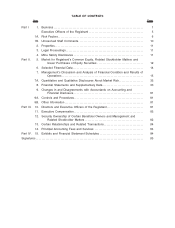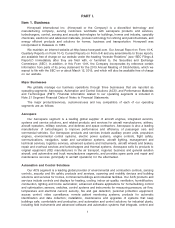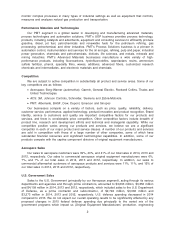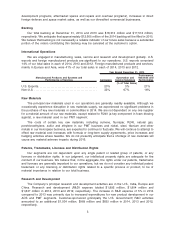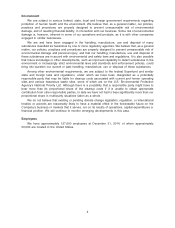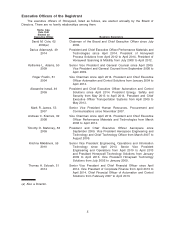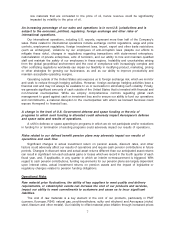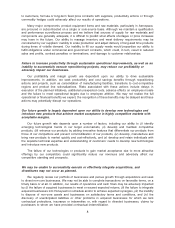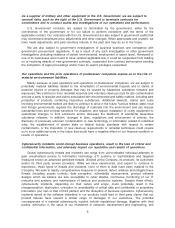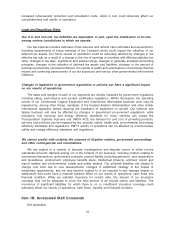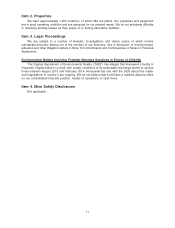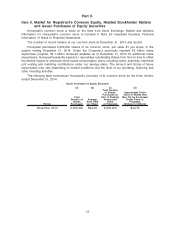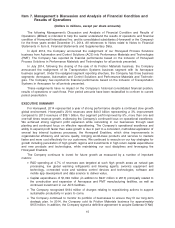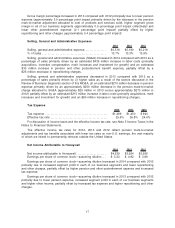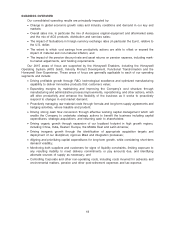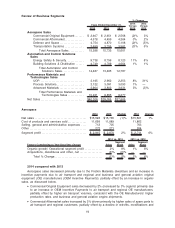Honeywell 2014 Annual Report Download - page 18
Download and view the complete annual report
Please find page 18 of the 2014 Honeywell annual report below. You can navigate through the pages in the report by either clicking on the pages listed below, or by using the keyword search tool below to find specific information within the annual report.As a supplier of military and other equipment to the U.S. Government, we are subject to
unusual risks, such as the right of the U.S. Government to terminate contracts for
convenience and to conduct audits and investigations of our operations and performance.
U.S. Government contracts are subject to termination by the government, either for the
convenience of the government or for our failure to perform consistent with the terms of the
applicable contract. Our contracts with the U.S. Government are also subject to government audits that
may recommend downward price adjustments and other changes. When appropriate and prudent, we
have made adjustments and paid voluntary refunds in the past and may do so in the future.
We are also subject to government investigations of business practices and compliance with
government procurement regulations. If, as a result of any such investigation or other government
investigations (including violations of certain environmental, employment or export laws), Honeywell or
one of its businesses were found to have violated applicable law, it could be suspended from bidding
on or receiving awards of new government contracts, suspended from contract performance pending
the completion of legal proceedings and/or have its export privileges suspended.
Our operations and the prior operations of predecessor companies expose us to the risk of
material environmental liabilities.
Mainly because of past operations and operations of predecessor companies, we are subject to
potentially material liabilities related to the remediation of environmental hazards and to claims of
personal injuries or property damages that may be caused by hazardous substance releases and
exposures. We continue to incur remedial response and voluntary clean-up costs for site contamination
and are a party to lawsuits and claims associated with environmental and safety matters, including past
production of products containing hazardous substances. Additional lawsuits, claims and costs
involving environmental matters are likely to continue to arise in the future. Various federal, state, local
and foreign governments regulate the discharge of materials into the environment and can impose
substantial fines and criminal sanctions for violations, and require installation of costly equipment or
operational changes to limit emissions and/or decrease the likelihood of accidental hazardous
substance releases. In addition, changes in laws, regulations and enforcement of policies, the
discovery of previously unknown contamination or new technology or information related to individual
sites, the establishment of stricter state or federal toxicity standards with respect to certain
contaminants, or the imposition of new clean-up requirements or remedial techniques could require
us to incur additional costs in the future that would have a negative effect on our financial condition or
results of operations.
Cybersecurity incidents could disrupt business operations, result in the loss of critical and
confidential information, and adversely impact our reputation and results of operations.
Global cybersecurity threats and incidents can range from uncoordinated individual attempts to
gain unauthorized access to information technology (IT) systems to sophisticated and targeted
measures known as advanced persistent threats, directed at the Company, its products, its customers
and/or its third party service providers. While we have experienced, and expect to continue to
experience, these types of threats and incidents, none of them to date have been material to the
Company. We seek to deploy comprehensive measures to prevent, detect, address and mitigate these
threats (including access controls, data encryption, vulnerability assessments, product software
designs which we believe are less susceptible to cyber attacks, continuous monitoring of our IT
networks and systems and maintenance of backup and protective systems. Despite these efforts,
cybersecurity incidents, depending on their nature and scope, could potentially result in the
misappropriation, destruction, corruption or unavailability of critical data and confidential or proprietary
information (our own or that of third parties) and the disruption of business operations. Cybersecurity
incidents aimed at the software imbedded in our products could lead to third party claims that our
product failures have caused a similar range of damages to our customers. The potential
consequences of a material cybersecurity incident include reputational damage, litigation with third
parties, diminution in the value of our investment in research, development and engineering, and
9



